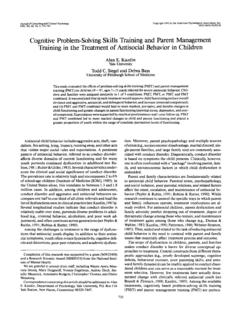Transcription of Diagnosis, Case Conceptualization, and Treatment Planning
1 3. Clinical Thinking Skills diagnosis , case conceptualization , and Treatment Planning Introducing Chapter 3: Reader Highlights and Learning Goals Individuals who choose careers as mental health professionals including counselors, psycho- therapists, social workers, counseling and clinical psychologists, psychiatrists, and those in similar career paths often enter the counseling field because earlier in their lives, in their families of ori- gin, in their schools and neighborhoods, and among their friends and peers, they previously found themselves in the role of good listener, intelligent analyzer, or effective problem-solver when those around them encountered life's difficulties (Neukrug & Schwitzer, 2006).
2 In other words, many people already are natural helpers when they decide to become professionals (Neukrug &. Schwitzer, 2006, p. 5). As natural helpers for friends and family, they have relied on their intuition, personal opinions, and natural inclinations as they spontaneously listen, support, analyze, encour- age, push, or make hopeful suggestions. However, the demands of professional counseling work go beyond the qualities needed by natural helpers. Compared with the spontaneous nature of natural helping, professional counseling requires us to rely on purposeful skills and to systematically guide the counseling relationship through a sequence of organized stages, intentionally aiming to achieve specific client outcome goals (Neukrug & Schwitzer).
3 That is, professional counseling requires us to become competent at using clinical thinking skills to facilitate [the] provision of mental health Treatment (Seligman, 1996, p. 23). These skills include diagnosis , case conceptualization , and Treatment Planning . The goal of our textbook is to help you understand and become competent at these three important clinical thinking skills. Part II of the text explores each skill in detail. In Chapter 3 we introduce all of the key concepts and then in Chapters 4, 5, and 6 we discuss them more fully. (Continued). 27. 28 PART II diagnosis , case conceptualization , AND Treatment Planning . (Continued). In the current chapter, first we discuss the role that clinical thinking skills play in counseling and psychotherapy.
4 Next, we define diagnosis , case conceptualization , and Treatment Planning . Following our definitions, we relate these skills to caseload management, and explain how they fit into the stages of the professional counseling process, and summarize. We then will be ready to explore each skill more fully in the separate chapters that follow. At the end of this chapter, you should be able to: Discuss the role of clinical thinking skills in counseling and psychotherapy as they are prac- ticed in today's professional mental health world Define diagnosis , case conceptualization , and Treatment Planning Distinguish among these skills and caseload management Summarize the stages of the professional counseling relationship and discuss where diagnosis , case conceptualization , and Treatment Planning fit into the process Be ready to move on to the three specific chapters that follow, dealing in detail with diagnosis , case conceptualization , and Treatment Planning The Use of Clinical Thinking Skills practice, evidence-based practice.
5 And other best in Counseling and Psychotherapy practice information (Wampold, 2001). Basch (1980) referred to all of this as listening like a The transition from natural helper to professional psychotherapist (p. 3). It means a lot of decision- counselor can be a daunting one. We become aware making responsibility rests on our shoulders. that a client's decision to seek counseling is an Correspondingly, to accomplish the shift from important investment in time, money, and energy natural helper giving advice at the dinner table (Vaughn, 1997, p. 181). We realize that when cli- or comforting a coworker who is upset to ents choose us as professional consultants for their counseling professional meeting in a therapeu- therapeutic journey, it takes substantial determi- tic setting with child, adolescent, young adult, nation for them to stay the course with us when the adult, couple, family, or group clients who are in going gets tough (p.)
6 181). We learn that counsel- need a set of tools is required with which to ors are responsible for helping the individual under- describe the client's functioning, gain an under- stand his or her own view of himself or herself and standing of the person's situation and needs, his or her life, discover new choices, create a new identify goals for change, and decide on the most view of himself or herself, and bring about his or effective interventions for reaching these goals. her own changes (Weinberg, 1996). We recognize Specifically, diagnosis is a tool for describing that when counseling succeeds, our clients should client needs, case conceptualization is a tool for be better able to form their own insights and apply understanding these needs, and Treatment plan- the benefits of psychotherapy to new life situations ning is a tool for addressing these needs to bring when they arise (Vaughn, 2007).
7 To accomplish about change. When employed by counseling these tasks, we make judgments about our clients, professionals, the Treatment plan follows directly decide what goals seem reasonable and feasible, from the case conceptualization , which builds on consider how we will communicate with our cli- the diagnostic impressions. All three of these ents, and determine how to implement the change clinical thinking skills are required competencies process (Basch, 1980). Further, we must pay atten- for today's counseling and psychotherapy pro- tion to what we know about empirically supported fessionals (Seligman, 1996, 2004). Chapter 3 Clinical Thinking Skills 29. Figure Clinical Thinking Skills case Treatment diagnosis Leads to Leads to conceptualization Planning Describing the Clinically Addressing the client's concerns understanding the client's concerns client's concerns Defining diagnosis method of organizing, naming, and communicat- ing information in as objective a fashion as pos- In today's professional counseling world, diag- sible.
8 The job of the counselor is to find the best nosis refers to the use of the Diagnostic and match between what the clinician observes the Statistical Manual of Mental Disorders, Fourth client to be experiencing and the various criteria Edition, Text Revision (DSM-IV-TR) (American for the different clinically significant patterns Psychiatric Association [APA], 2000a) to iden- found in the DSM. This type of diagnosis can tify and describe the clinically significant pat- help us determine the primary focus of counsel- terns associated with our clients' distress or ing. For example, a focus on a mood problem impairment or risk. Certainly there are other might need different counseling responses than a mental health diagnostic systems besides the focus on anxiety complaints, and a focus on an DSM-IV-TR.
9 The World Health Organization's adjustment problem would be addressed differ- (WHO) International Classification of Diseases, ently than a focus on long-term life problems Tenth Edition (ICD-10) is an important example. like personality disorders. Further, some fields of counseling and psycho- The DSM-IV-TR provides about 300 separate therapy maintain their own systems of diagnostic diagnoses. It includes disorders of infancy, child- formulation; for instance, there are psychoana- hood, adolescence, and adulthood; describes lytic systems for diagnosing client personality both short-term client concerns, such as adjust- structures (McWilliams, 1994, 1999). However, ment disorders, and longer-standing problems, it is the DSM-IV-TR that is the widely accepted, such as mental retardation and personality disor- official nomenclature for making a mental health ders; covers a wide range of behavior, from diagnosis in today's clinical practice.
10 It is used substance abuse to sleep disorders to bereave- throughout the United States and, increasingly, ment; and pays attention to characteristics of around the world. The DSM-IV-TR has been thought, mood, behavior, and physiology. A fully translated into more than 14 languages. As men- prepared, start-to-finish DSM diagnosis requires tal health professionals who work with multiple five different types of information, each of which constituencies and colleagues of various helps the counselor to describe what the client is disciplines, mastering the DSM-IV-TR is a pro- experiencing or presenting. Each of the five fessional survival skill for counselors and psy- types of information is called an Axis, and taken chotherapists in all settings and contexts.



















